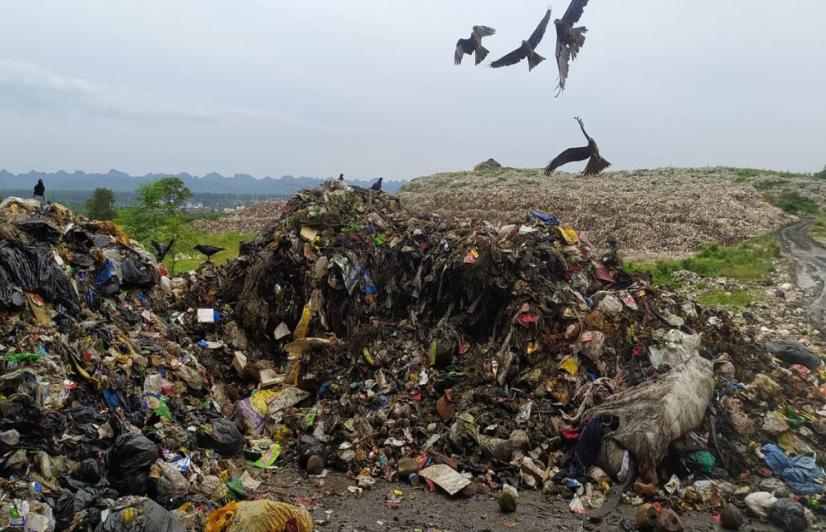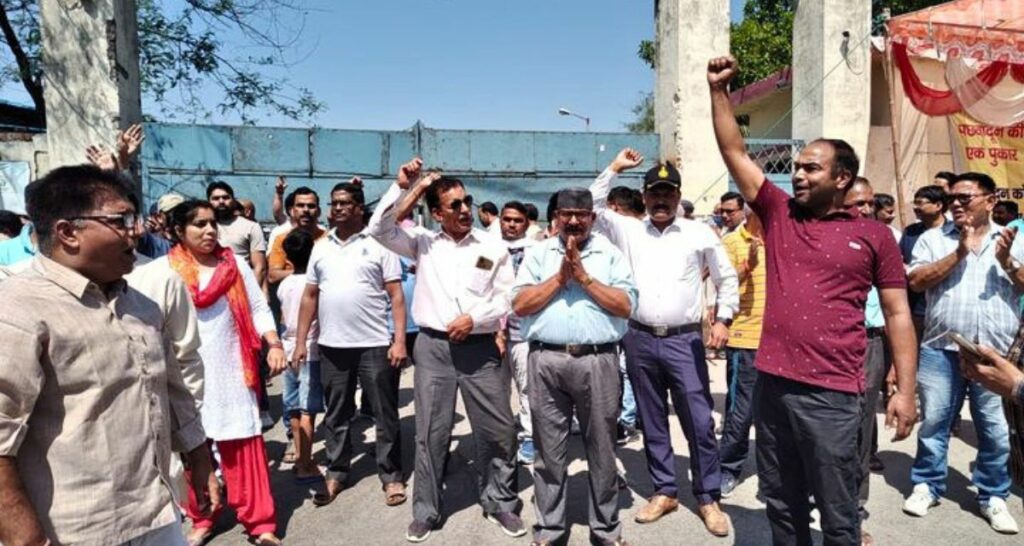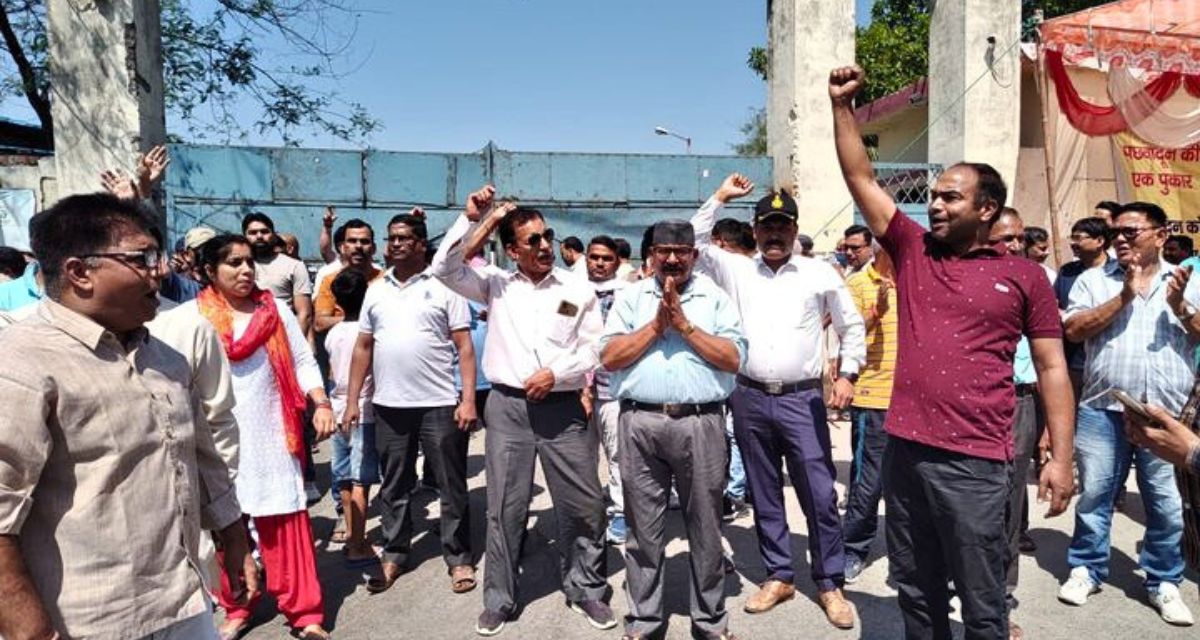By Satyam Kumar
The journey to Paonta Sahib, about 20 km from Dehradun, has turned into a distressing ordeal for commuters due to the overpowering stench emanating near Sheeshambada. For over four years, residents of Sheeshambada and its surrounding villages have endured this misery.
After the inception of Uttarakhand in 2000, Dehradun was made the temporary capital, leading to a rapid rise in population and subsequently, garbage in the city. Sixteen years later in 2016, the construction of a Rs 23.50-crore waste disposal plant near Sheeshambada village and on the banks of the Asan river was initiated to get rid of this problem. Yet, the facility near Sheeshambada emerged with a foul odour, leading to public outcry.
In 2018, under the Municipal Corporation’s Solid Waste Management Scheme, the Sheeshambada Compost Plant and the Sanitary Landfill Site was inaugurated by the then Chief Minister Trivendra Singh Rawat.

The contract of the Sheeshambada Solid Waste Management Plant was given to Ramky Private Limited and a few months after its commencement, people living in its vicinity started facing the problem of foul odour. Despite repeated complaints, no solution was found. Eventually, Rajendra Gangsari, secretary, Pachhwa Doon Sangharsh Samiti, who was agitating against the plant, filed a petition to the National Green Tribunal (NGT) to shift the plant.
Taking cognisance, the NGT formed a high-level committee to look into the functioning of the plant. The committee found multiple flaws in the functioning of the plant and in November 2022, the contract was handed over to the National Federation of Farmers on Procurement Processing and Retailing Cooperative India Limited (NACOF) from the current operator, Ramky Group. The Tribunal even instructed the Uttarakhand Government to find a solution to waste management in the city.
The battle, however, continues as Sheeshambada grapples with pollution, proximity concerns, and operational hurdles.
Residents of Sheeshambada at the receiving end
On one side of the plant is Himgiri Ji University. According to the university, the stench is so strong that even if the doors of the classrooms are closed, it is difficult to sit comfortably.
Kushum Bhatt, a resident of Baya Khala, said, ‘Our house is about half a km away from this plant. We face the issue of this foul smell throughout the day. Our children complain of headaches and we are hesitant to invite anyone to our home because of the stench.’ Bhatt rued that eagles and crows kept hovering over the garbage in the plant and would pick some of it along with dirt and pollute the nearby areas, including the homes in the vicinity.

Jitendra Kumar Gupta, another resident, said in April 2022, a massive fire broke out in the plant. The blaze couldn’t be controlled for days and resulted in air pollution, thus leaving many people gasping for breath. Information sought by the RTI from the Selakui Fire Officer shows that from January 1, 2017, to April 18, 2023, no fire extinguishers were installed at the garbage disposal centre.
Waste plant ops challenges
Reportedly, the Sheeshambada plant can dispose of 300 tonnes of waste per day. According to the 2020-21 annual report of the Uttarakhand Pollution Control Board, the plant receives garbage from the Dehradun Municipal Corporation as well as three additional urban local bodies — Mussoorie (18 tonnes), Vikas Nagar (10 tonnes) and Harbatpur (three tonnes) — daily. The inquiry committee report, however, revealed that about 450 tonnes of solid waste was received from various bodies every day.
According to the report of an inspection carried out from January 2018 to September 30, 2022, a total of 5.81 lakh metric tonnes (LMT) of urban solid waste has been brought for processing, of which 2.88 LMT is stored in the sanitary landfill and has not been segregated.
Wet and dry waste is brought to the plant without separating it, resulting in it not being completely segregated.
According to the Solid Waste Rules 2016, it is the responsibility of the waste generator to separate the biodegradable and inorganic waste generated at the plant and give it to the collector. Due to the improper disposal of the effluents coming out of the garbage dump, it was found seeping from the wall of the plant. This increases the possibility of water pollution in the Asan River due to its close proximity to the plant.
Dr Avinash Khanna, Chief Municipal Health Officer at Municipal Corporation Dehradun, tells 101Reporters that Ramky’s main focus was on waste to energy, due to which the pile of Refuse-Derived Fuel (RDF) in the plant was continuously increasing. But the new company NACOF has installed a new machine that can dispose of RDF every day. The work of the new company is much better, but because most of the garbage in Dehradun is mixed, there is a lot of problem in the disposal of garbage in the plant. So we are trying to separate the dry and wet garbage directly at the homes.
Dr. Khanna further says that work is happening in parallel to move the garbage disposal plant from Shishambada. ‘We have identified a piece of land belonging to the forest department and further work is being done for the same. Along with this, our talks with IIT Roorkee have been concluded to get rid of the pile of garbage in the Sheeshambada plant and soon the DPR will be ready and further action will also be taken soon.’
Inappropriate location
In December 2012, in the meeting of the Expert Appraisal Committee (EAC) regarding the construction of the Shishambada Garbage Disposal Centre, it was proposed that the plant is quite close to the Asan River, so another place should be found for it.
However, on April 6, 2013, the project proponent said the plant was 400 m away from the river, so it does not fall into a floodplain. The project proponent also placed this point before the Supreme Court Monitoring Committee (SCMC). To this, the SCMC said the geographical location of Dehradun was such that all places were the catchment areas of one or the other water source and it was difficult to find alternative areas.
But once again the committee of the EAC’s Regional Office, Lucknow, investigated and found that the project is surrounded by a university, officers’ colony, residential areas and a river, and the project proponent cited the SCMC order.

In September 2014, the ECA granted permission to the project with certain conditions and recommendations, including fulfilment of the environmental impact assessment conditions.
Talking to 101Reporters, Pachhwa Doon Sangharsh Samiti secretary Gangsari said the Shishambada Waste Disposal Centre was not built on the river banks, but on the riverbed itself. ‘We have been opposing the plant ever since its construction started in 2016. The area residents protested and also laid siege to the plant,’ he said, adding that in April 2022, when this plant caught fire there was a demonstration, following which Chief Minister Pushkar Singh Dhami ordered the District Magistrate to find new land for the plant.
Need to opt for compact plants
Bijay Bhatt of Doon Science Forum said Dehradun was such a city that it was not possible to accurately measure the amount of garbage generated daily because a large quantity also depends on tourists. ‘One can’t tell when the number will increase. So, instead of disposing of the garbage generated in Dehradun city in only one place, small garbage disposal centres should be made in each ward. This will be helpful as even if the garbage increases, the burden on all centres will rise only marginally,’ Bhatt said, adding that they were also facing the problem of garbage segregation in Dehradun.
Notably, a study conducted by activists Anita Joshi and Neeraj Joshi on Nathuvawala Sanitation Park, established by the Municipal Corporation and the Feedback Foundation, in Ward No. 100 of Dehradun found that carrying out waste segregation at small levels was effective. The study revealed that around 2 to 2.5 tonnes of garbage is daily generated in this part of the ward, which has a population of about 20,000. This waste is being disposed of in a scientific manner as per the Solid Waste Rules 2016.
However, the Nathuwala Swachhata Park in Dehradun presents a contrasting picture. The distinction arises from a prior waste separation system that has been successfully implemented. Thanks to the efforts of the Feedback Foundation, residents have been sensitised to their role in managing household waste effectively, encouraging the separate disposal of wet and dry waste. This concerted endeavour has not only simplified the tasks of park personnel but has also resulted in an entirely hassle-free park environment. Notably, the absence of waste accumulation speaks volumes about the effectiveness of this initiative.
Satyam Kumar is a Uttarakhand-based freelance journalist and a member of 101Reporters, a pan-India network of grassroots reporters
About the author(s)
101Reporters is a pan-India network of grassroots reporters that brings out unheard stories from the hinterland.






